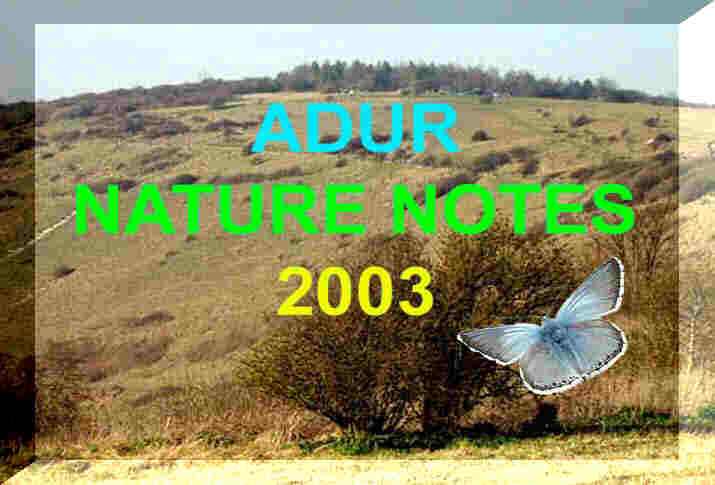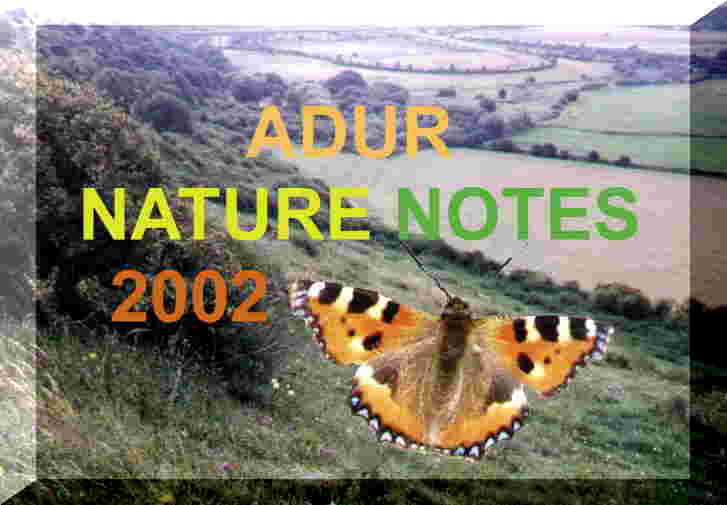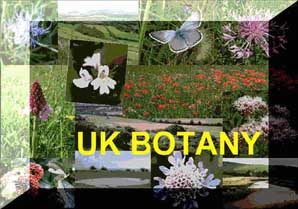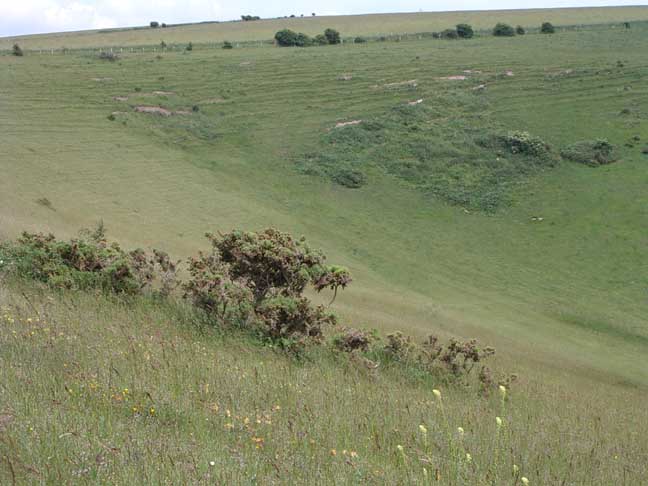 |
|
|
 |
 |
|
NATURE NOTES 2000 |
 |

|
| Adur Flood Plain |
| Chalk Downs |
| Coastal Fringe |
| Intertidal (Seashore) |
| River Adur Estuary |
| River Adur Flood Plain |
| Sea (off Sussex) |
| Town & Gardens |
| Widewater Lagoon |
|
|
South
Downs: Beeding Hill
including
Anchor
Bottom and meadows
and
Golding Barn area
SSSI
site
Beeding Hill the high point on the downs near Shoreham is 169 metres (554 feet) above sea level.Wild Flower Gallery
Photographs by Andy Horton
Greater Knapweed Harebell
Cycling Route to Mill Hill
Friends of Lancing Ring (External Link)
WILDLIFE REPORTS 2004 >26 March 2005
An Osprey was seen flying north over Beeding Hill at 11:30 am.Report from Stanley Allen on Sussex Ornithological Society News
4 March 2005
Looking from the Grinstead Lane bridge, Lancing, towards the north-east, a thin coating of snow has settled on Truleigh Hill on the far side of the Adur valley gap. The distant hills backing Brighton are all coated in white.Report by Ray Hamblett on the Lancing Nature Notes Blogspot
21 July 2004
Cows were grazing on the upper slopes of the field that includes Anchor Bottom and there seemed to be wet cow pats near the Dacre Gardens entrance at Upper Beeding, where two Marbled White Butterflies were seen. Scabious was commonly growing on the slopes. I am not clear about identifying the Field Scabious and Small Scabious, but these ones had rudimentary leaves like the few on the lower slopes of Mill Hill.29 June 2004
Access to Anchor Bottom is possible from the north end of Dacre Gardens at Upper Beeding. This is the famous area for the Green-winged Orchids, but they were no longer in flower. This orchid is still present in thousands.
It is an undergrazed cow pasture with long grasses, clovers, but also Pyramidal Orchids, Yellow Wort, Restharrow, Selfheal, and other calicoles.
Small Heath Butterflies are found here and there were at least 15, slightly more than the number of Meadow Browns, with a a few Small Tortoiseshells and at least one Common Blue Butterfly.
Adur Butterfly List 200413 June 2004
I saw about half-a-dozen brand-new Large Skippers at Golding Barn, near Upper Beeding.Report by Jim Steedman
25 May 2004
The first Common Blue Butterfly of 2004 was spotted in the buttercup strewn field north-west of Beeding Hill car park.Almost immediately afterwards I saw what looked more like an Adonis Blue on the top slopes of Anchor Bottom. Anchor Bottom was decorated in yellow but this was from buttercups (possibly Creeping Cinquefoil) not Horseshoe Vetch (food plant of caterpillars of the Adonis Blue) but despite the absence (maybe scarcity) of the food plant this identification is probable. A minute or two later on the chalk and flint lane from Beeding Hill to Castletown, a Holly Blue Butterfly fluttered around the bushes that lined each side of the bridleway.
Skylarks were in song and flight over the downs and a dozen or so Rooks probed the soil on Beeding Hill with their silver beaks.
A small ladybird on a Dove's-foot Crane's-bill (Geranium) was a tiny (2 mm long) yellow beetle with black spots. The most likely species is the Sixteen-spot Ladybird, Tytthaspis sedecimpunctata.
British Insects Yahoo Group
The Coleopterist
British Beetles Yahoo Group
Adur Ladybirds10 May 2004
East of Mill Hill, the first Rook appeared, followed by a pair east of Erringham Hill, and at Anchor Bottom and Beeding Hill to the north over 300 Rooks probed in the grasslands. Alas, the cow pasture at Anchor Bottom was just dried cow pats (without the cows) and attendant mushrooms.
There were scores of these dome-shaped Panaeolus sphinctrinus mushrooms by the dried cow pats. Historically, the exposed west facing escarpment of Anchor Bottom had a reputation for butterflies, but there was a complete* absence of both Horseshoe Vetch and Bird's Foot Trefoil (the important food plants for blue butterflies). (* I searched acres of ground and fastened my binoculars on any hints of yellow, which included Silverweed and Cowslips.) The only butterfly on the downs was a Small Tortoiseshell nectaring on an Oil Seed Rape flower on the edge of an arable field. At the foot of the South Downs Way path as it crosses the Steyning to Shoreham road, my first Orange Tip Butterfly of the year fluttered by, the flicker of the orange wing tips of the male pleasing to observe. (* Later, Jim Hoare was able to discover patches of Horseshoe Vetch on the path going north to Golding Barn where the livestock cannot graze.)
16 April 2004
On the unadopted, chalk and very flinty road from Beeding Hill to Castletown, there was the yellow fluttering of a Brimstone Butterfly and a clump of Cowslips.Report by Jan Hamblett (Lancing Nature)
6 July 2003
Late in the afternoon whilst cycling on the bridleway to the south east
of Beeding Hill, I heard one male Quail calling very distantly to the south
west. (TQ 220 093)Report from Dave Green on Sussex Ornithological Society News
14 June 2003
As I climbed the steep path from the South Downs Way Footbridge over the Adur to Beeding Hill I heard the Skylarks in song and saw their familiar outlines in the sky. Small Tortoiseshell Butterflies increased in frequency and I must have spotted 30 but some could be the same butterfly following me. There was just a solitary faded Painted Lady Butterfly that landed in front of me.

Top half of Anchor Bottom (near Beeding Hill) from the meadow to the NE
The photograph above shows the grazed meadow that contained a few battered Pyramid Orchids, Anacamptis pyramidalis, and a handful of better condition Fragrant Orchids, Gymnadenia conopsea. Kidney Vetch, Anthyllis vulneraria, were noticeable.
On the roadside verges at the top of the hill in the picture, I saw a handful of the first Meadow Brown Butterflies of 2003.
22 April 2003
A Pheasant was feeding in a stubble field (west side) on the way up to Beeding Hill from Mill Hill.20 April 2003
A Dingy Skipper Butterfly was seen by the side of the Industrial Estate at Golding Barn near Upper Beeding (near Steyning) in the Adur valley on a breezy overcast Easter Sunday morning. This species is not often recorded, although it it is known from Mill Hill.Report by Jim Steedman via the UK-Leps EForum19 October 2002
Six Small Tortoiseshell Butterflies were seen between Beeding Hill and Truleigh Hill.Report by Allen Pollard via the UK-Leps EForum31 August 2001
On an overcast day, following a shower, a Small Copper Butterfly was seen at Beeding Hill flying rapidly over towards Anchor Bottom, skirting the hedgerows on the bumpy lane down to Castletown, where a Speckled Wood Butterfly in reasonably good condition settled.
12 September 2000
A few female Common Blue Butterflies were seen near Beeding Hill.
This is a female Common Blue. The white flecks on the wings are typical of female Common Blues found on calcareous soils. Andrew Daw.Three or four species of Dragonflies hawked/darted over the Downs. In order of frequency, they appear to be (subject to confirmation):
Emperor Dragonfly (frequent 30+) Anax imperator
(Some of these could have been the Migrant Hawker, Aeshna mixta on reflection. However, despite the late in the year flying time, the size of the Emperor should make them unmistakable, so they were probably present.)
Common Darter (frequent 70+) Sympetrum striolatum
(Some were blue-grey the others orange-brown and red)
British Dragonfly Society
UK Dragonflies Yahoo Group
Adur Damselflies & Dragonflies
European Dragonflies Picture Gallery11 June 2000
Martin Davies surprised a Roe Deer when cycling between Truleigh Hill and New Erringham Farm over the downs route to Mill Hill. It was in the arable field on the east side near Beeding Hill.
South
Downs (AONBs)
South
Downs: Chalk Cliffs (pic.)
View
of the downs north of Mill Hill from the River Adur valley (Link)
Coombes (the other side of the valley)
85
million years ago, Cretaceous Period (144 - 66.4 million years ago):
Sussex is covered by a warm sea inhabited by ammonites, Micraster
and other urchins, molluscs, at a lower latitude (Continental Drift: Tectonic
Plate Theory). Sedimentary deposits of foraminiferans such as Globigerina
and coccoliths (microscopic plankton with a calcium carbonate shell) lay
down the chalk (Pic) which is rock of the
South Downs near Shoreham.
The Wayfaring Tree is well named as it is found beside footpaths and old sheep trails, possibly thriving on the extra nutrients in the sheep's latrine.
(It is not easy to explain the steepness of the eastern and western boundaries of the Adur Valley cutting through the South Downs north of Shoreham, although they may have been created by melt water and weathering in periglacial times).
- Geology
Page
South
Downs AONBs (Countryside Agency)
South
Downs (Friends of the Earth)
South
Downs Way
Countryside
Agency
Council
for National Parks
East
Sussex Ecology Page
Sussex downland AONBs = 981
sq. km.
Butterflies:
Small Tortoiseshell Aglais urticae Clouded Yellow Colias croceus Meadow Brown Maniola jurtina Marbled White Melanargia galathea Large White Pieris brassicae Gatekeeper Pyronia tithonus Speckled Wood Pararge aegeria Small Copper Lycaena phlaes Painted Lady Vanessa cardui Common Blue Polyommatus icarus Small Heath Coenonympha pamphilus Adonis Blue Polyommatus bellargus
Common Blues on Chalk Downsfrom "Andrew Daw"
Subject: RE: New file uploaded to uk-leps (photograph above)Hello,
This is a female Common Blue. The white flecks on the wings are typical of female Common Blues found on calcareous soils (Chalk, limestone, ...).
The amount of blue on the wings vary from butterfly to butterfly,
even in the same colony. The extremes in the range (totally blue,
or totally brown) are not so common.Andrew
> -----Original Message-----
> From: uk-leps@egroups.com
The Common Blue caterpillar feeds on Bird's Foot Trefoil.
.
- Local
Wildlife Links (SE England)
Adur
& the Downs: Protected Sites
Adur
Valley Nature Notes 2002
Adur
Valley Wildlife
Butterfly
Conservation Society
Chalk
& Flint Link
Dungeness,
Kent, England
Lancing
Ring
Orford
Ness: Coastal Ecology of a Shingle Bank (excellent references)
Ralph
Hollins Nature Pages (Chichester Harbour area)
Rye
Harbour Nature Reserve
Rockpooling
Page
Seashore
Page
Shingle
Coast (Coastal Fringe of Shoreham Beach)
Shoreham-by-Sea
Wildlife Page
South
Downs History (External) site
South
Downs Way (by Allen Pollard)
Southwick
Hill
Sussex
Archaeological Society
Sussex
Archaeological Society EGroup
Sussex
Archaeology & Folklore
Sussex
Wildlife Web Sites
UK
Dragonflies Discussion Group
UK-LEPS
Discussion Group (for Butterflies and Moths)
Lancing
Ring & Mill Hill Information 1 (requires Acrobat Reader)
Lancing
Ring & Mill Hill Information 2 (requires Acrobat Reader)
|
|
|
|
|












